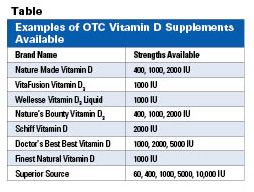Publication
Article
Pharmacy Times
The Important Role of Vitamin D
Author(s):
Vitamin D, which aids the body's immune and skeletal systems in various ways, is available in many foods and in many OTC nutritional supplements.
Ms. Terrie is a clinical pharmacy writer based in Haymarket, Virginia.

Vitamin D is a fat-soluble vitamin that is naturally present in a few foods, is added to other foods, and is available in many nutritional supplements. Vitamin D has the properties of both a hormone and a vitamin and is necessary for mineral homeostasis and proper formation of bone.1,2 Vitamin D is available in 2 forms, which includes ergocalciferol (vitamin D2) and cholecalciferol (vitamin D3). Cholecalciferol is the naturally occurring form of vitamin D that is synthesized in the skin from endogenous or dietary cholesterol upon exposure to sunlight.1 The ergocacliferol form is often used as a food additive.1
The major biological function of vitamin D is to maintain normal blood levels of calcium and phosphorus.1-3 Vitamin D aids in the absorption of calcium, helping to form and maintain strong bones. Recent research also suggests that sufficient intake of this fat-soluble vitamin may provide protection from and decrease an individual’s risk of developing osteoporosis, hypertension, cancer, and several autoimmune diseases.1-3 Studies report that it triggers the body’s immune cells to produce antibodies; therefore, vitamin D promotes an overall increase in the strength of the immune system.4 To date, more than 500 studies support the role of vitamin D in immune health.4 Results from some studies report that vitamin D assists in the maintenance of joint and muscle comfort, as well as the maintenance of a healthy mood, and supports breast, colon, and prostate health.4 Many multivitamins formulated for women have increased amounts of vitamin D to at least 800 IU.
Although many individuals typically obtain adequate amounts of vitamin D through sunlight exposure and dietary sources, some individuals may be at a greater risk for deficiencies, especially during the winter months. According to the US National Center for Health Statistics, some studies report that an estimated 70% of individuals in the United States may be considered vitamin D deficient.4
Patient populations who may be at a high risk for vitamin D deficiencies include the elderly, obese individuals, exclusively breastfed infants, and those who have limited sun exposure.1,2,4,5 In addition, individuals who have fat malabsorption syndromes, such as cystic fibrosis or inflammatory bowel disease like Crohn’s disease, are at risk for being vitamin D deficient.1,2,5 The use of certain medications such as phenytoin and carbamazepine may increase the metabolism of vitamin D.1,5 These agents increase the hepatic metabolism of vitamin D to inactive compounds and reduce calcium absorption.6 On the other hand, the use of corticosteroids may impair the metabolism of vitamin D; therefore, these patients should be monitored for adequate vitamin D levels.1,5
Factors that may also reduce the amount of vitamin D an individual will synthesize from sunlight include the following7:
• Living closer to the polar regions, particularly during winter months
• Use of sunscreen
• Darker skin pigmentation
• High levels of air pollution
• Dense cloud covering
In 2008, the American Academy of Dermatology issued an updated position statement on vitamin D after reviewing the most recent evidence regarding its role in the maintenance of optimal health.8,9 Currently, the American Academy of Pediatrics recommends 400 IU per day of vitamin D3 taken with food for children.4,6 A minimum of 1000 IU per day of vitamin D3 is recommended for healthy adults. In some cases, higher doses of vitamin D may be necessary for those patients with vitamin D deficiency or certain health conditions. These patients should be referred for further medical evaluation and should not self-treat, because these dosages should be determined by a physician.4
To avoid vitamin D toxicity, the US Food and Nutrition Board has set an upper daily intake limit of 2000 IU for those individuals older than 1 year and 1000 IU for infants.1,7 The new dietary reference intakes for vitamin D are expected to be released in 2010, and will likely reflect an increase in the daily requirement for vitamin D.4 According to a study reported in the November 2009 issue of Pediatrics, more than 6.3 million children in the United States are not getting enough vitamin D.10 Another study showed that 7 of 10 US children have very low levels of vitamin D, thus putting them at risk for cardiovascular disease, rickets, and weak bones.11
Since the emergence of various studies producing positive results regarding the role of vitamin D in the decrease and/or prevention of various chronic diseases, a greater interest has surfaced in exploring the benefits of adequate vitamin D in human health.12 Furthermore, various epidemiologic studies have reported strong associations between vitamin D levels and the incidence of several infectious diseases, such as septic shock, respiratory infections, and influenza. Results from studies indicate, however, that more detailed studies are needed to fully understand the relationship between an individual’s vitamin D status and one’s response to fighting infectious diseases.13 In addition, the results of a meta-analysis reported in the October 2, 2009, online issue of the British Medical Journal showed that high-dose vitamin D supplementation may decrease the risk of falling among older individuals.14
Results from another study investigating low vitamin D levels in older men reported that high-dose supplemental vitamin D may reduce the risk of nonvertebral fractures by as much as 20% and hip fractures by at least 18%.15 According to study results presented at the 2009 American Heart Association’s 63rd High Blood Pressure Research Conference, premenopausal women with vitamin D deficiency are at an increased risk for systolic hypertension.16
For more information on clinical trials studying vitamin D, please visit the National Institutes of Health’s clinical trials Web site at www.clinicaltrials. gov/ct2/results?term=vitamin+d.
Nonprescription Vitamin D Supplements
Currently, several vitamin D supplements are available as single-entity products or in multivitamin supplement products; some products contain a combination of vitamin D and calcium. These products are available in a variety of formulations, including capsules, tablets, liquids, and sublingual tablets to meet the specific needs of various patient populations. For vitamin D supplementation, vitamin D3, the natural form of vitamin D, is preferred over vitamin D2, because vitamin D3 is most effective in maintaining adequate levels of vitamin D in the human body.4,9
Patients suspected of having a nutritional deficiency should be referred for further medical evaluation when warranted. Pharmacists can also identify those patients at risk for possible drug— nutrient interactions and make clinical recommendations accordingly. When recommending the various vitamin D supplements available, pharmacists should remind patients to adhere to the recommended dosages unless otherwise directed by their primary health care provider. Patients should also be reminded to check the content of vitamin D in any other supplements that they may be taking to avoid possible therapeutic duplication or toxicity. Although toxicity is rare, patients experiencing any of the signs of vitamin D toxicity, such as weakness, headache, somnolence, nausea, vomiting, dry mouth, a metallic taste, constipation, or muscle or bone pain, should immediately consult their primary health care provider.17 â–

For pharmacist-recommended Supplements, visit http://www.otcguide.net/v_vitamin_d
References
1. Berardi RR, Newton G, McDermott JH, et al, eds. Handbook of Nonprescription Drugs. 16th ed. Washington, DC: American Pharmacists Association; 2009.
2. Vitamin D. Medline Plus Web site. www.nlm.nih.gov/medlineplus/druginfo/natural/patient-vitamind.html. Accessed December 4, 2009.
3. Barclay L. Management of vitamin d deficiency reviewed. Medscape Web site. www.medscape.com/viewarticle/712007. Accessed December 4, 2009.
4. The importance of vitamin D. Nature Made Web site. www.naturemade.com/ImmuneHealth/product_vitamin_d.html. Accessed December 5, 2009.
5. Bordelon P, Ghetu MV, Langan RC. Recognition and management of vitamin D deficiency. Am Fam Physician. 2009;80(8):841-846.
6. Dietary supplement fact sheet: vitamin d. National Institutes of Health Office of Dietary Supplements Web site. http://dietary-supplements.info.nih.gov/factsheets/vitamind.asp#h9. Accessed December 5, 2009.
7. Vitamin D supplementation. Centers for Disease Control and Prevention Web site. www.cdc.gov/breastfeeding/recommendations/vitamin_d.htm. Accessed December 5, 2009.
8. Barclay L. American Academy of Dermatology issues updated position statement on vitamin D. Medscape Web site. www.medscape.com/viewarticle/706024_print. Accessed December 5, 2009.
9. Position statement on vitamin D. American Academy of Dermatology Web site. www.aad.org/forms/policies/uploads/ps/ps-vitamin%20d.pdf. Accessed December 4, 2009.
10. 6 million US kids lack enough vitamin D. Medline Plus Web site. www.nlm.nih.gov/medlineplus/news/fullstory_91055.html. Accessed December 4, 2009.
11. 7 in 10 US kids have low vitamin D. Medscape Web site. www.medscape.com/viewarticle/706938. Accessed December 4, 2009.
12. Moyad MA. Vitamin D: a rapid review. Medscape Web site. www.medscape.com/viewarticle/589256. Accessed December 5, 2009.
13. Yamshchikov AV, Desai NS, Blumberg HM, Ziegler TR, Tangpricha V. Vitamin D for treatment and prevention of infectious diseases: a systematic review of randomized controlled trials. Endocr Pract. 2009;15(5):438-449.
14. Barclay L. High-dose vitamin D supplement may reduce risk of falling among older people. Medscape Web site. www.medscape.com/viewarticle/709829. Accessed December 5, 2009.
15. Orwoll E, Nielson CM, Marshall LM, et al. Vitamin D deficiency in older men. J Clin Endocrinol Metab. 2009; 94(4):1214-1222. Accessed December 4, 2009.
16. Brown AJ. Vitamin D deficiency in younger women may up risk of hypertension. Medscape Web site. www.medscape.com/viewarticle/709474. Accessed December 4, 2009.
17. Buck ML. Prevention and management of vitamin D deficiency in children. Part II. Vitamin D supplementation. Medscape Web site. www.medscape.com/viewarticle/707757. Accessed December 4, 2009.







